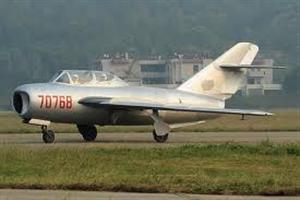Shenyang J-5
Shenyang J-5 is Chinese tactical fighter based on Soviet MiG-17F.
In October 1954 China decided to build the MiG-17F Fresco-C day fighter. It was powered by the VK-1F afterburning turbojet rated at 2,600 kgp (5,730 lbst) dry and 3,380 kgp (7,450 lbst) reheat; as on the earlier version. The armament comprised one 37-mm (1.45 calibre) Nudel’man N-37D cannon with 40 rounds and two 23-mm (.90 calibre) Nudel’man/Rikhter NR-23 cannons with 80 rounds per gun. This fighter (later called Shenyang J-5) was had first flown on 29th September 1951 and was then the cur¬rent production version.
A manufacturing licence was obtained, and the manufacturing documents were handed over in 1955 together with two pat¬tern aircraft, 15 completely-knocked-down (CKD) kits and materials for a further ten air¬craft. The Soviet Union also supplied the jigs and tooling and proposed a four-stage pro¬gramme facilitating production entry.
The Shenyang Aircraft Factory started assembly of the first MiG-17F from Soviet components on 8th April 1955; the first fight¬er made entirely of locally manufactured com-ponents was completed on 13th July 1956. A static test airframe was successfully tested to destruction on 26th July.
Meanwhile, seriailed Zhong 0101 (the hieroglyph ‘Zhong’ is the first part of China’s native name, Zhong-Guo), the first locally- manufactured aircraft (construction number 0101 – that is. Batch 01, 01st aircraft in the batch) made its first flight on 19th July 1956 at the hands of factory test pilot Wu Keming. The flight tests continued until 2nd August that year. On 8th September the State Committee cleared the machine for full-scale production. The prototype was ultimately preserved at the People’s Liberation Army Air Force Museum in Datangshan (now called Xiaotangshan) near Beijing and listed as an ‘Important Historical Monument’ by the Chinese government.
The licence-built version was originally known locally as the Dongfeng-101 (East Wind-101) and Type 56 but was redesignated Shenyang J-5 in 1964. The VK-1F turbojet entered licence production at the Harbin Engine Factory as the WP-5 (Wopen-5 – turbojet engine, type 5), or TJ-5 for export; the first engine passed acceptance trials on 19th June 1956. The J-5’s performance was almost identical to that of the Soviet-built MiG-17F. Export J-5s were designated F-5 and supplied prima¬rily to Albania.
 To meet a PLANAF requirement the Shenyang factory developed a torpedo-bomber version of the MiG-17F (Shenyang J-5). The heavy torpedo was carried under the fuselage; this required one of the cannons to be removed and the fuel load to be reduced so as not to exceed the MTOW. Trials showed that performance (except field performance) had deteriorated sharply as compared to the standard Shenyang J-5 because of the high drag generated by the tor¬pedo and the reduced fuel capacity. Thus the torpedo bomber did not progress beyond the prototype stage; work in this direction contin¬ued with the Nanchanq Q-5B.
To meet a PLANAF requirement the Shenyang factory developed a torpedo-bomber version of the MiG-17F (Shenyang J-5). The heavy torpedo was carried under the fuselage; this required one of the cannons to be removed and the fuel load to be reduced so as not to exceed the MTOW. Trials showed that performance (except field performance) had deteriorated sharply as compared to the standard Shenyang J-5 because of the high drag generated by the tor¬pedo and the reduced fuel capacity. Thus the torpedo bomber did not progress beyond the prototype stage; work in this direction contin¬ued with the Nanchanq Q-5B.
At least one Shenyang J-5 serialled ‘2424 Red’ was con¬verted into an avionics testbed for an unidentified Chinese radar. The radar antenna was housed in a bulbous radome on the intake’s upper lip; the aircraft’s appearance was thus quite similar to the Soviet SP-2 – an experi¬mental version of the MiG-15 equipped with a Korshun (Kite, the bird) radar that presaged the MiG-17P/PF.
